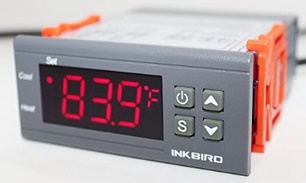Home Site Map - Techniques - Interior Infrastructure -
Heating - Principles
Take a step back and consider house heating from first principles.
Concrete at internal living space temperature
The house walls and floors are all one huge block of concrete. Concrete is great at storing heat, ie once you have heated it up it takes a long time to cool down, particularly if it is separated from the cold outside air thanks to lots of insulation. Note that the insulation needs to be mainly on the outside of the concrete walls. You don't want insulation on the inside of the concrete walls because you want the thermal mass tightly coupled to the inside air temperature.
To achieve the above, you should have about 8" of polystyrene (EPS) on the outside of the concrete wall. My wall building method known as Carnation Walling achieves this.
But what heats the internal concrete?
Typically when people talk about the benefits of thermal mass they describe how sun coming through the windows heats the thermal mass that then slowly releases the heat over the evening and night. That passive solar heating is great, but the thermal mass can benefit you in other ways. One example is with a wood burning fire.
If you have a wood burning fire you know that it throws out a huge amount of heat, but the logs burn out all too quickly. In practice you can't be bothered or forget, particularly late in the evening, to go and add more logs so it goes out and stops giving heat. If you have lots of thermal mass then the temperature in your house will be nicely evened out. While the fire is going full blast, the concrete will stop you getting too hot, and after the fire has gone out, the concrete will keep you warm.
Meeting Energy Code requirements
Calculation suggests my house needs a worst case of 20,000 Btu/hour to heat it but the likely figure is probably in practice more like 15,000 Btu/hour.
You can meet this requirement with a bunch of 1500W oil filled radiators (each give about 5,000 Btu) which is the solution I used on my planning application to satisfy the Washington Energy Code requirements. I will install these radiators (in the wall wainscoting), but in practice I don't plan to actually use them.
Point source heating
If a house (such as mine) is designed with...
1) Super-insulation
2) Lots of concrete within the thermal envelope to provide
thermal mass
3) A fairly open floor plan
...then to a reasonable extent you can heat it from a point source without worrying about ducting to distribute the heat around.
The heat point source could be a wood burning fire or it could be a Ductless MiniSplit or it can be anything else within the house envelope that generates heat.
Electricity nice - make your own
Using electrically powered heaters in your home is nice because you have the option of installing PhotoVoltaic (PV) solar panels to make your own electricity. Sending power back into the grid provides a way to essentially store the power you make on a sunny day and get it back on a cold night. I prefer not to use gas or oil heating because it does not have that option.
There are two ways to get heat from electricity - resistive heating or heat pump. Using a heat pump will get you more than twice as much heat per watt of electricity compared with resistive. Resistive heating is close to 100% efficient at extracting the energy from electricity, but you can regard a heat pump is something like 220% efficient because it extracts heat energy from somewhere else and moves it to where you want it at a temperature you want.
Temperature measurement and control
When designing a heating system it your house it is good to monitor everything about it. This allows you to set it right for maximum comfort but it is also fun in a geeky sort of way. Luckily temperature monitoring / thermostat switching units are very inexpensive (under $15) so you can afford to sprinkle them liberally around your house.
Dehumidier
In damp climates it is worth having a dehumidier available for use.
Further reading
There's an excellent piece from Martin Holladay on heating super-insulated homes at... http://www.greenbuildingadvisor.com/blogs/dept/musings/heating-tight-well-insulated-house




